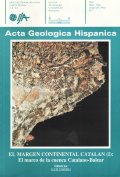Características generales de las subcuencas del margen peninsular meditarráneo ("Rift" del Surco de Valencia)
Abstract
This paper describes the general characteristics, namely the geometry and the sedimentary infill, of several troughs of Tertiary age present in the off-shore eastem Mediterranean margin of Spain. Al1 of them are included within the Valencia Trough, a rift basin developed during Paleogene and early Miocene times between the Balearic archipelago and mainland Spain. Although some authors (Soler et al., 1983; Fontboté et al., 1990; Roca and Desegaulx, 1992; Watts and Torné, 1992; Martínez del Olmo, 1994) have recently described the Valencia Trough as a foredeep basin of the Betics, we think that the referred foredeep does not extend as far as to the westernmost area of the Mediterranean. This is based on the evidence provided by the interpretation of numerous seismic surveys and nearly two hundred wells drilled without finding a single repetition or a clear evidence of compression in the area of this study. This rift is tbe southemmost branch of the European rift, which crosses most of western Europe from the Rhine graben through the westem Alps southwards into Morocco along the eastem coast of Spain (Sanz de Galdeano, 1990; Fontboté et al., 1990).
The substratum of the basin is basically formed by Mesozoic (mainly carbonates) and pre-Mesozoic sediments (mainly clastics and metamorphics), folded and deformed during the Pyrenean orogeny and later fractured as horsts and grabens during the rift stage. The carbonates were severely fractured and intensively karsted during subaerial exposure following the deformation of the region. These processes have enhanced tbeir reservoir cbaracteristics (porosity and permeability) thus allowing the accumulation of hydrocarbons.
Aborted during middle Miocene times, this rift started its development in the north during Paleogene times (Rosas and Barcelona troughs) and the sediments of this age constitute the bulk of the infill. On the contrary, in the southern sub-basins (Tarragona and Castellón troughs) the formation of the rift was younger, dunng early middle Miocene times, and the bulk of sediments infilling the troughs are of this age. This change in the age of the sedimentary infill, younger towards the south paralells the southwards development of the main rift. The sediments were filling the rift troughs, and by middle Miocene times al1 reliefs (horsts and grahens) had been leveled off.
During early Miocene times the sedimentation in the troughs (mainly starved basins) took place under restricted marine conditions that favored the accumulation and preservation of the organic matter and the subsequent development of hydrocarhon source beds in some of them (Demaison and Bourgeois, 1984).
The high thermal gradient, typical of rift hasins, favored the early maturation of the organic matter. The migration of the newly generated hydrocarbons into the neighbour paleoreliefs, mostly formed by karsted carbonates (Martínez del Olmo and Esteban, 1983), brought about severa1 oil fields that have been actively explored and exploited.
So far only in the Tarragona trough commercial accumulations have been found (Amposta, Casablanca, Dorada and Tarraco) but other troughs (namely Rosas and Barcelona) have had good shows and the geocheniical analysis have also demonstrated the existence of good source rocks.
Frorn the middle Miocene on, the sedimentation changed dramatically to a prograding continental shelf of passive margin type. Two megasequences are distinguished: the first one during the rniddle-late Miocene and the second one during Plio-Quatemary times, separated by the Messinian unconformity that locally produced important erosional canyons in the underlying sediments.


